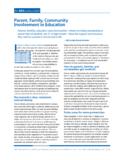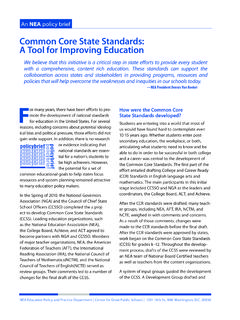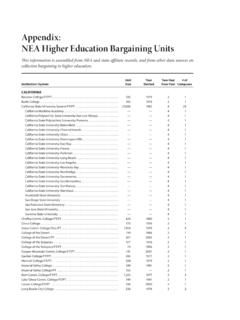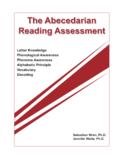Transcription of Early Childhood Education and School Readiness
1 An NEA policy brief Early Childhood Education and School Readiness All children need and deserve a good start. Attending high quality Early Childhood programs is an important part of starting Early and starting right. NEA President Dennis Van Roekel N. EA is concerned about the growing number Research continues to confirm the benefits of quality of children who enter kindergarten already Early Childhood programs. Some examples: behind their peers socially and academically. Two studies published in Developmental Evidence suggests this School Readiness gap Psychology 3 documented the benefits of universal begins before children enter pre-K programs (serving four-year-olds) and Early School and places children at Head Start programs (serving infants, toddlers, and risk of failure in School .)
2 The their families) on children's cognitive and language Association believes all children development, especially for children from low- deserve access to Early learning income families. opportunities that will increase their chances for success in School and in life. The pre-K study in Oklahoma 4 (Oklahoma is the only state to offer preschool to virtually every four- What are the benefits of high quality year-old) found significant improvements in stu- Early Childhood Education ? dents' reading, writing, and spelling abilities, while Two of the best known longitudinal studies on the the Early Head Start study 5 showed gains in chil- long-term benefits of Early Childhood Education are dren's social and emotional development and the High/Scope Perry Preschool Project 1 and the health as well as enhanced family support for chil- Abecedarian Early Childhood Intervention Project.
3 2 dren's learning. The Perry project found that individuals who were Researchers made a point of noting that the enrolled in a quality preschool program ultimately preschool program was staffed by well-educated, earned up to $2,000 more per month than those well-trained teachers who earn regular public School who were not, and that young people who were in salaries. preschool programs were more likely to graduate from high School , to own homes, and to have longer Early Childhood Education makes marriages. The Abecedarian project offered similar good economic sense and equally compelling results: Children in quality A high ranking Federal Reserve Bank official, Art preschool programs are less likely to repeat grades, Rolnick, senior vice president and director of research need special Education , or get into future trouble of the Federal Reserve Bank of Minneapolis, said in a with the law.
4 Published report in 2003 6 that a good preschool can NEA Education Policy and Practice Department | Center for Great Public Schools | 1201 16th St., NW, Washington, 20036. An NEA policy brief offer a 12 percent annual return, after inflation. That's from low-income communities. better than the stock market, he notes, and any other Financing: Both federal government and state social program. governments should use new money to provide Yet, even though Early Childhood Education funds sufficient to make prekindergarten available for programs promise sure-fire returns, the country is all three- and four-year-old children. not making this investment. The latest national Integration of prekindergarten and other Early survey of state preschool programs conducted by Childhood programs: Collaborative efforts at the state the National Institute for Early Education Research and local levels enable prekindergarten programs to (NIEER) concluded that across our nation, high- be offered in a variety of settings in order to quality and readily available state-funded maximize use of limited resources.
5 Collaborations at preschool programs are the exception rather than the local level can include coordination between the rule. 7. schools, Head Start, and other Early Childhood NEA believes it is time to change that. programs. This kind of collaboration can offer additional support and stability to working families. NEA's Policy, Positions, and Programs NEA urges states to make high quality Early Childhood At the 2003 Representative Assembly, NEA's highest Education programs a priority and consider them an policy making body, the Association adopted two integral part of the Education continuum. States seminal recommendations: should encourage and support the efforts of public schools in their efforts to provide Early Childhood NEA believes that all three- and four-year-old chil- programs.
6 Funding for new or expanded Early dren should have access to high quality, publicly Childhood programs in the public schools should funded, universal prekindergarten programs. come from new funding sources and be a shared NEA believes that states should mandate full- responsibility of national, state, and local day kindergarten attendance for every five-year-old governments. child. NEA believes high quality Early The Association supports universal access to high Childhood programs are rooted in quality prekindergarten programs for all three- these characteristics: and four-year-old children whose parents wish to enroll them. Well-rounded curriculum that enhances the cogni- tive, physical, social, and emotional domains of each NEA recommends that School -based prekindergarten child's development.
7 Programs work collaboratively with existing Early Childhood programs to provide universal access to Small class sizes and favorable teacher-child ratios;. high quality Early Education experiences that address Teachers and administrators who are caring and the needs of children and families: well-trained in Early Childhood Education and child Universal access: State initiatives should strive to development;. make prekindergarten programs available to all Ancillary services ( , professional development, three- and four-year-old children when sufficient curriculum supervision, and assessment and evalua- funding exists. In cases where funding is inadequate tion) that support children's development through or does not exist, priority should be given to children curriculum implementation.
8 2 NEA Education Policy and Practice Department | Center for Great Public Schools | 1201 16th St., NW, Washington, 20036. An NEA policy brief Parents working actively as partners with teachers 4. in fostering appropriate child outcomes; 5. Love, J., et al., The Effectiveness of Early Head Start for Programs that address child health, nutrition, and 3-Year-Old Children and Their Parents: Lessons for Policy other family needs as part of a comprehensive service and Programs, Developmental Psychology 41, no. 6 (2005): network. 885-901. 6. Rolnick, A., & R. Grunewald, Early Childhood Develop- References ment: Economic Development with a High Public Return 1. L. J. Schweinhart, J. Montie, Z. Xiang, W. S. Barnett, C. R. (Minneapolis, MN: Fedgazette).
9 Belfield & M. Nores. (2005). Lifetime Effects: The High/Scope pubs/fedgaz/03-03 Perry Preschool Study Through Age 40 (Ypsilanti, Michigan: 7. Barnett, S., et al., The State of Preschool: 2005 State Pre- High/Scope Educational Research Foundation). School Yearbook, The Annual Report, (Rutgers, New Jersey: The National Institute for Early Education Research). 2. Abecedarian Early Childhood Intervention Project, ~abc/. 3. Gormley, The Effects of Universal Pre-K on Cognitive Development, Developmental Psychology 41, no. 6 (2005): 872-884. Resources Full-Day Kindergarten: An Advocacy Guide: This NEA publication offers tools, resources, and research to help Association leaders, staff, and other Early Childhood Education advocates secure full-day kindergarten programs in their states.
10 It contains research, organizing tools, policy recommendations, model legislation, and case studies from states that have enacted full-day kindergarten. (PDF, , 52 pages), 2006. NEA on Prekindergarten and Kindergarten: NEA's policy road map for Early Childhood Education , developed by NEA's Special Committee on Early Childhood and adopted by the NEA Representative Assembly. org/earlychildhood/ (PDF, 748KB, 16 pages), 2004. NEA Education Policy and Practice Department | Center for Great Public Schools | 1201 16th St., NW, Washington, 20036 3. An NEA policy brief 4 NEA Education Policy and Practice Department | Center for Great Public Schools | 1201 16th St., NW, Washington, 20036. 2008 (PB03).










